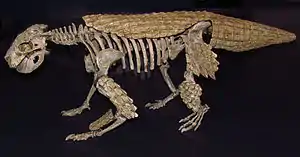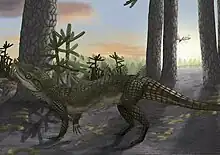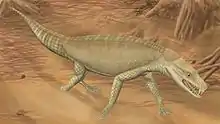Notosuchia
Die Notosuchia sind eine Gruppe der Crocodylomorpha, die während der Kreidezeit lebten. Fossilien wurden in Südamerika, Afrika und Asien gefunden. Die Notosuchia lebten terrestrisch (landbewohnend). Es sind verschiedene Ernährungstypen bei den Notosuchia bekannt: So lebte Chimaerasuchus herbivor (pflanzenfressend), Simosuchus omnivor (allesfressend) und Baurusuchus carnivor (fleischfressend).
| Notosuchia | ||||||||||||
|---|---|---|---|---|---|---|---|---|---|---|---|---|

Lebendrekonstruktion von Notosuchus, der namensgebenden Gattung der Notosuchia | ||||||||||||
| Zeitliches Auftreten | ||||||||||||
| Albium (Unterkreide) bis Maastrichtium (Oberkreide) | ||||||||||||
| 112,9 bis 66 Mio. Jahre | ||||||||||||
| Fundorte | ||||||||||||
| Systematik | ||||||||||||
| ||||||||||||
| Wissenschaftlicher Name | ||||||||||||
| Notosuchia | ||||||||||||
| Gasparini, 1971 |
Merkmale
Notosuchia waren kleine bis mittelgroße, kurzschnäuzige Krokodile.[1] Die Gruppe schließt viele Gattungen mit sehr spezialisierten Merkmalen mit ein, darunter Säugetier-ähnliche Zähne, flexible, schutzschildartige Körperpanzerungen, die denen der heutigen Gürteltiere ähneln (Armadillosuchus),[2] und möglicherweise fleischige Wangen und an Schweine erinnernde Schnauzen (Notosuchus)[1].
Diese Unterordnung wurde erstmals 1971 von Zulma Gasparini wissenschaftlich beschrieben, erfuhr seitdem jedoch mehrere phylogenetische Revisionen. Laut Gasparini lässt sich diese Gruppe durch eine Reihe von Merkmalen von anderen Gruppen abgrenzen: Beispielsweise waren Schädel und Schnauze verhältnismäßig kurz. Das Antorbitalfenster war offen, und nicht geschlossen, wie bei einigen anderen Krokodilgruppen. Die Augenhöhlen (Orbita) waren seitlich am Schädel gelegen. Die Zahnreihe war kurz.[3]
Systematik
Es folgt ein Kladogramm nach Sereno und Larrson (2009):[4]

| Notosuchia |
| |||||||||||||||||||||||||||||||||||||||||||||||||||||||||
Familien und Gattungen




_1.jpg.webp)

- † Candidodontidae Carvalho, Ribeiro & Avilla, 2004
- † Candidodon Carvalho & Campos, 1988
- † Malawisuchus Gomani, 1997
- † Uruguaysuchidae Gasparini, 1971
- † Ziphosuchia Gasparini, 1971
- † Libycosuchidae Stromer, 1914
- † Libycosuchus Stromer, 1914
- † Pakasuchus O’Connor et al., 2010
- † Simosuchus Buckley, Brochu, Krause & Pol, 2000
- † N. N.
- † Coringasuchus Kellner et al., 2011
- † Labidiosuchus Kellner et al., 2011
- † Morrinhosuchus Iori & Carvalho, 2011
- † Notosuchidae Dollo, 1924
- † Notosuchus Woodward, 1896
- † Mariliasuchus Carvalho & Bertini, 1999
- † Sphagesauridae Kuhn, 1968
- † Adamantinasuchus Nobre & Carvalho, 2006
- † Armadillosuchus Marinho & Carvalho, 2009
- † Caipirasuchus Iori & Carvalho, 2011
- † Caryonosuchus Kellner et al., 2011
- † Sphagesaurus Price, 1950
- † Yacarerani Novas et al., 2009
- † N. N.
- † Doratodon Seeley, 1881
- † Chimaerasuchidae Carvalho, Ribeiro & Avilla, 2004
- † Chimaerasuchus Wu, Sues & Sun, 1995
- † Comahuesuchidae
- † Comahuesuchus Bonaparte, 1991
- † Sebecosuchia Colbert, 1946
- † Pehuenchesuchus Turner & Calvo, 2005
- † Baurusuchidae Price, 1945
- † Pabwehshi Wilson, Malkani & Gingerich, 2001 – Maastrichtium – Pakistan[5]
- † Cynodontosuchus Woodward, 1896 – Coniacium bis Santonium – Argentinien
- † Gondwanasuchus Marinho, Iori, Carvalho & Vasconcelos, 2013
- † Pissarrachampsinae Montefeltro, Larsson, & Langer, 2011
- † Campinasuchus Carvalho et al., 2011
- † Pissarrachampsa Montefeltro, Larsson, & Langer, 2011
- † Wargosuchus Martinelli & Pais, 2008 – Santonium – Argentinien[6]
- † Baurusuchinae Montefeltro, Larsson, & Langer, 2011
- † Aplestosuchus Godoy, Montefeltro, Norell & Langer, 2014
- † Baurusuchus Price, 1945 – Turonium bis Santonium – Brasilien (Adamantina-Formation)[7]
- † Stratiotosuchus Campos, Suárez, Riff & Kellner, 2001 – Turonium bis Santonium – Brasilien (Adamantina-Formation)
- † Iberosuchidae Antunes, 1975
- † Iberosuchus Antunes, 1975
- † Bergisuchidae Rossmann, Rauhe & Ortega, 2000
- † Bergisuchus Berg, 1966 – Eozän – Brasilien
- † Sebecidae Simpson, 1937
- † Ilchunaia Rusconi, 1946
- † Barinasuchus Paolillo & Linares, 2007
- † Lorosuchus Pol & Powell, 2011
- † Ayllusuchus Gasparini, 1984
- † Bretesuchus Gasparini , Fernandez & Powell, 1993
- † Langstonia Paolillo & Linares, 2007
- † Sahitisuchus Kellner, Pinheiro & Campos, 2014
- † Sebecus Simpson, 1937
- † Zulmasuchus Paolillo & Linares, 2007
- † Wanosuchidae Zhang, 1981
- † Wanosuchus Zhang, 1981
- † Libycosuchidae Stromer, 1914
Einzelnachweise
- Lucas Fiorelli, Jorge O. Calvo: New remains of Notosuchus terrestris Woodward, 1896 (Crocodyliformes: Mesoeucrocodylia) from Late Cretaceous of Neuquen, Patagonia, Argentina. In: Arquivos do Museu Nacional. Bd. 66, Nr. 1, 2008, ISSN 0365-4508, S. 83–124.
- Thiago S. Marinho, Ismar S. Carvalho: An armadillo-like sphagesaurid crocodyliform from the Late Cretaceous of Brazil. In: Journal of South American Earth Sciences. Bd. 27, Nr. 1, 2009, ISSN 0895-9811, S. 36–41, doi:10.1016/j.jsames.2008.11.005.
- Zulma B. de Gasparini: Los Notosuchia del Cretácico de América del Sur como un nuevo Infraorden de los Mesosuchia (Crocodilia). In: Ameghiniana. Bd. 8, Nr. 2, 1971, ISSN 0002-7014, S. 83–103, online.
- Paul C. Sereno, Hans C. E. Larsson: Cretaceous crocodyliforms from the Sahara (= ZooKeys. Bd. 28, Special Issue.). Pensoft, Sofia 2009, ISBN 978-954-642-518-8, doi:10.3897/zookeys.28.325.
- Jeffrey A. Wilson, M. Sadiq Malkani, Philip D. Gingerich: New crocodyliform (Reptilia, Mesoeucrocodylia) from the Upper Cretaceous Pab Formation of Vitakri, Balochistan (Pakistan). In: University of Michigan. Contributions from the Museum of Paleontology. Bd. 30, Nr. 12, 2001, ISSN 0097-3556, S. 321–336, online.
- Agustín G. Martinelli, Diego F. Pais: A new baurusuchid crocodyliform (Archosauria) from the Late Cretaceous of Patagonia (Argentina). In: Comptes Rendus Palevol. Bd. 7, Nr. 6, 2008, ISSN 1631-0683, S. 371–381, doi:10.1016/j.crpv.2008.05.002.
- Carlos Roberto A. Candeiroa, Agustín G. Martinelli, Leonardo S. Avilla, Thomas H. Rich: Tetrapods from the Upper Cretaceous (Turonian–Maastrichtian) Bauru Group of Brazil: a reappraisal. In: Cretaceous Research. Bd. 27, Nr. 6, 2006, ISSN 0195-6671, S. 923–946, doi:10.1016/j.cretres.2006.05.002.